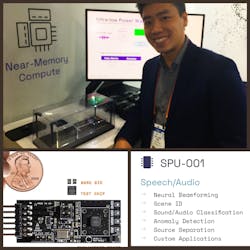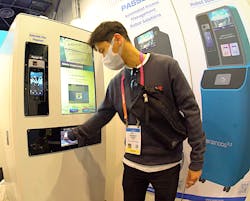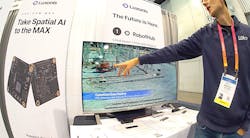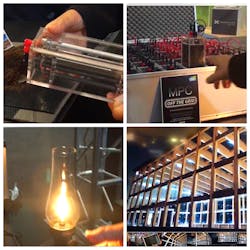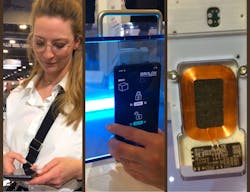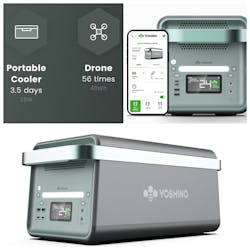Surfaro on the Scene at CES 2023 - Part 1: Scientific Advancements to Impact Security
With 1,000 more exhibitors than last year and more than double last year’s attendance, this year’s CES show revealed several significant trends impacting everything from IoT to entry screening, to smart, safe, and sustainable cities.
Walking each jam-packed show floor required navigation through pavilions, show floor sections, walking the entire perimeter, and striking a balance between planned visits and exhibitors within categories that might not appear significant on the show’s site, but turned out to be amazing “ninja innovators,” as described by CTA’s President, Gary Shapiro.
This is the first of a three-part series on the cutting-edge tech that I discovered at CES, with an overall focus on how these advancements – many of which come from the automobile, energy and other adjacent industries – will eventually impact the security industry. Part one here will focus on scientific advancements I discovered that will apply directly to our industry. Part two will outline finds that will impact the smart/sustainable city and buildings markets; and part three will focus on how software and AI processing will change the game for security.
As for part one, CES 2023 saw a significant increase in Original Equipment Manufacturers (OEM) as exhibitors. Exhibitors like Hailo (coming in part three), Femtosense, Luxonis, Tripod and Stiwa provide devices and subsystems part of a solution provider’s offering. This coverage of OEMs can guide budgeting and product selection with greater accuracy.
Also included are significant advances in power technology. The impact of improved power systems for the planet are significant. A simple 2% efficiency gain in power systems across the world can present an equivalent opportunity to reduce CO2 emissions generated by 97 coal-fired power plants. The entry of no-power security and safety lighting and locking technology at CES 2023 contribute to reasonable and desirable energy transition.
Femtosense: AI-Based Sound Monitoring
Armed with a round of funding in Q3 2022, smart noise reduction solution provider Femtosense returned to CES with an AI chipset, software and inference processor ready to integrate into third-party ear buds, recorders, cameras, etc. This is known as the Sparce Processing Unit (SPU).
“We’re very excited to start working with customers that need to detect crashes, accidents, angry voices and normal conversations in challenging environments,” CEO and founder Sam Fok told me. “With these earphones, you walk around on the show floor and regardless of the different noises, they eliminate the noise, and lets an important conversation through.”
He demoed the earphones while playing construction noise, including a jackhammer, in the background. “The software tracks theWith the SPU, Femtosense has greatly reduced audio path latency that affects sound, on a power budget that can run all day on a hearing aid or rechargeable battery, won’t overheat, and at a reasonable product margin. Basically, it is a potential life-saving, low-cost, high-performance sound and speech processing solution.
Speech intelligibility is critical on 911 calls, in active shooter scenarios, vehicle accidents, riots, in challenging places like airports, and busy municipal areas. The SPU can support all of these, in addition to keyword recognition, like “gun” or “officer down” for automatically and reliably initiating a life-saving rescue.
Deep learning algorithms are different than legacy techniques; the ultra-low power, ultra-fast SPU learns what is speech and what is not, as it is trained on a massive amount and variety of noises and environments, rather than tuned filters that try to characterize speech frequencies. This “leap-forward” sparsity-aware-training (SAT) reduces complexity and works on many deep learning problems, not just speech enhancement.
The SPU-001 development board is available now for cameras, audio stations and wearables, but will most likely be in widespread first in hearing aids or hearing augmentation for construction workers and first responders. http://Femtosense.ai
GST: Automated Visitor Management
Global Security Technology (GST)’s Braindog Passbot automates the entire process of identifying visitors, issuing passes by applying facial recognition, vein or iris authentication, after verifying a government-issued ID.
Team Manager Jae woo Baek led me through a demonstration of several entry scenarios, designed to reduce visitor wait times in scenarios such as power plants or government buildings.
“It has a no-touch facial recognition and body thermal checking system, so if you have a fever, it doesn’t give you a pass,” BaekVisitors can check a “personal identification release,” answer a Covid questionnaire, then face the unit’s biometric sensor array, which Baek said works with a mask and sunglasses on. Its capacity is 100 passes at any time.
Currently in use by the Korean government, Coast Guard and police departments, the system
has numerous configurations, including integration with electronic access control, visitor management, contactless gates, and visitor location systems.
GST scales Passbot through a MediaIS AI Simulation that can create machine learning predictive models for applied functions like disaster prevention and response, and status of electric grid.
Luxonis: Giving Robots Depth Perception
Luxonis develops AI software and cameras for robotics, and already supplies robotic solution providers in the security, life safety, healthcare, construction and smart buildings/city markets. At CES, it showcased new OAK devices that use DepthAI API, a spatial AI platform for robots to perceive the world like a human can – including visual features and location.
The much-awaited OAK-D Pro-PoE generated high interest at CES, as it now includes an infrared laser dot projection system allowing the camera to actively measure depth. Previously, this was performed passively from a stereo camera module. The laser dot projection system can be set for flood mode, providing no-light computer vision capabilities, especially useful in perimeter surveillance.Luxonis also received a CES 2023 Innovation Award for the OAK-SoM-Max, a System on Module (SoM) designed for integration into top-level systems with a need for lower-power, high performance, real-time AI, and depth perception. This aligns with the strong industry trend putting more power and the established DepthAI API into a wide range of use cases, where the SOM’s feature set can help scale robot deployment. www.luxonis.com
Tripod Design: Harvesting Power from Soil, Compost and more
Perhaps the most significant exhibit in the IoT pavilion was Tripod Design’s micropower cell, invented by CEO Satoshi Nakagawa, that harnesses electricity through electrodes installed in natural objects like soil, compost, food scraps, water, and even wine.
Micropower Collection Design & Technology (MPC) “Off-The-Grid” is capable of pathway security and architectural lighting. Professor Nakagawa demonstrated how an array of these cells can light a powerful LED lamp visible for about a mile, or completely illuminate aA version of the micropower cell is thin, compact, with one side 3D printed carbon, the other oxidized metal, and activated with salt water in a life jacket, simplifying search and rescue operations.
“We don’t need big power and big lighting, this [Off-The-Grid LED lighting] is enough,” Nakagawa said. “We will be able to set up underground cells for continuous path lighting, and eventually even highway illumination.
Safely illuminating a country’s coastline is most likely the first use, and Nakagawa said the U.S. and Japanese Coast Guard are very interested. https://tripoddesign.com
Stiwa Group: Smart Locks that Don’t Need Dedicated Power
Dr. Christina Offenzeller of the Stiwa Advanced Products Group demonstrated the Smalox zero-power lock in the Austrian Pavilion.
“This is a completely passive device – if you want to unlock this panel, you open a secure app on your phone, hold it on the lock, it unlocks, and as soon as you move the phone away, it loses power,” Offenzeller explained. “When we are finished it will be NFC [enabled], and at the moment, we are aiming for mobile solutions, last-mile delivery, and pickup stations in front of large buildings. Doors will be a possibility.”The lock does not require any cables or power supply, receiving all power from the phone. This is a breakthrough for many industries requiring cost-effective locking devices to secure goods that need to travel while being secure and tracked. Cannabis growers, for example, often have a choice of securing goods in preparation and packaging areas or deploying a video surveillance system. Smalox flips that choice. www.stiwa.com/en/manufacturing/advanced-products/smalox
Yoshino: Fast-Charging Batteries
Yoshino batteries are the first power stations built around solid electrolyte or “solid state power” in place of flammable liquid electrolyte found in traditional lithium-ion batteries. By doubling the power-to-weight ratio, the new B4000-SST power station can fast-charge to 80% in about 70 minutes, charge a drone about 60 times, a full-size refrigerator for 14 hours, and a 42” LED TV for 22 hours.
Perimeter fixed cameras for event monitoring can often be powered for 5 times the duration of legacy batteries of the same size. Additional power stations may be chained to increase reserveThe Gallium nitride (GaN) contained in the batteries is not a new technology; in fact, GaN is found in the blue light scanner that reads Blu-Ray Discs. It can sustain elevated temperatures and require less materials dedicated to cooling to keep the power station working properly, in a compact package. https://yoshinopower.com
Steve Surfaro is Chairman of the Public Safety Working Group for the Security Industry Association (SIA) and has more than 30 years of security industry experience. He is a subject matter expert in smart cities and buildings, cybersecurity, forensic video, data science, command center design and first responder technologies. Follow him on Twitter, @stevesurf.
About the Author

Steve Surfaro
Steve Surfaro
Steve Surfaro is Chairman of the Public Safety Working Group for the Security Industry Association (SIA) and has more than 30 years of security industry experience. He is a subject matter expert in smart cities and buildings, cybersecurity, forensic video, data science, command center design and first responder technologies. Follow him on Twitter, @stevesurf.

